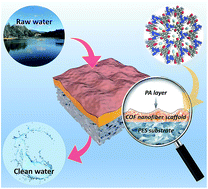Ultra-permeable polyamide membranes harvested by covalent organic framework nanofiber scaffolds: a two-in-one strategy†
Abstract
Polyamide-based thin-film composite nanofiltration membranes are widely used for potable water decontamination, brackish water desalination and wastewater reutilization. However, enhancing the water permeance of the polyamide layer within the thin-film composite nanofiltration membrane still remains a great challenge, because of the relatively large thickness and high transport resistance of the polyamide layer produced by intractable interfacial polymerization. Herein, we reported a two-in-one strategy to prepare ultra-permeable nanofiltration membranes via covalent organic framework (COF) nanofiber scaffold mediated interfacial polymerization. The highly porous and hydrophilic COF nanofiber scaffolds enhanced the controlled release of amine monomers, leading to ultrathin polyamide layers. Also, the relatively smooth COF nanofiber scaffolds can be spontaneously evolved into rugged and uneven architectures during interfacial polymerization, providing rough substrates for enlarging the actual areas of polyamide layers. Therefore, the increased areas of polyamide layers were employed as additional water permeable domains. Arising from the synergetic effect of the ultrathin and increased water permeation domains, the produced membranes exhibit exceptional nanofiltration performance with a water permeance of up to 31.1 L m−2 h−1 bar−1 and a Na2SO4 rejection rate of about 95%, outperforming most other nanofiltration membranes. This highly accessible technique opens a new avenue for the design and engineering of ultra-permeable thin-film composite nanofiltration membranes, highlighting its great potential in providing clean water.



 Please wait while we load your content...
Please wait while we load your content...